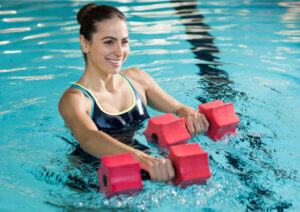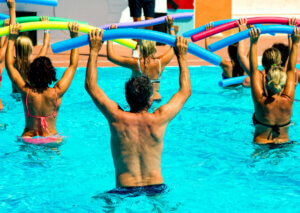All You Need to Know About Water Aerobics

Water aerobics is also known by many other names, including waterobics and aquafit. In this article, we’ll tell you all you need to know about water aerobics.
Water aerobics is a fitness activity that’s completely done in the water. You might have the preconception that this an activity for older people, but in reality, this is an option for any age group.
What is water aerobics?
Water aerobics is normally performed in a swimming pool, and the exercises are done differently because of the resistance of the water itself.
The swimming pools tend to be between four and five feet deep with a temperature of between 82 and 87 °F. There are also different variations.
One variation is aqua-cycle, which is a form of spinning where the bike is underwater. This is a great form of exercise for people with knee problems.
Another variation is the aqua-step, which uses an underwater step to train the lower body and the cardiovascular system.

If you’re looking for a bit more fun, then there’s the option of Aqua Zumba. And if you’re looking to reduce stress, there are few things better than Aqua Boxing, which combines different martial arts techniques.
If you’re interested in something more relaxing, there’s always Aqua Yoga, Aqualates, (to work your abdominals and back), or Ai Chi, which mixes wushu and tai chi, all in the water!
Basic water aerobics exercises
If it’s your first time taking a class in the water, it’s probably best to start with something easy and not too demanding. Then you can start increasing the intensity and get the most out of this activity.
The first thing you’ll need to do is warm up, and the simplest way to do this is by walking. Simply walk forward and backward in the water, making very deliberate, intense movements. Then, you can try flexing and extending your arms and legs, which is a good exercise for correcting your posture.
You can also do exercises against the edge of the pool. For example, hold onto the edge and rest your feet on the wall of the poo. Then, lightly bend your knees and move your body from side to side. Though you might not realize, you’ll be working your oblique abdominals.
The most common exercise in water aerobics is the starfish exercise. To do this, stand facing the side of the pool with your feet shoulder-width apart. Then, grab firmly onto the side with your right hand and leave your left arm down by your side with the palm of your hand facing the side of the pool.
Next, lift your outstretched left arm upwards whilst gently rotating your body so that it’s diagonal. Your arm should touch your ear when you’ve finished moving.
At the same time, stretch out the right leg and keep it in this position. This exercise will stretch your back and your oblique muscles. Repeat with the other side.
Finally, there’s the ballerina exercise, which consists of holding onto the side with both hands and float in the water. Once in position, move your legs crossing over one another, passing the right over the left and vice versa.

What parts of your body do you work?
In principle, water aerobics was developed for older people or to help people recover from muscle, joint, or bone injuries. However, since then, it’s become increasingly popular with all sorts of people owing to its health benefits.
According to the Revista Internacional de Medicia y Ciencias de la Actividad Física y el Deporte (International Journal of Medicine and Science of Physical Activity and Sport), in a water aerobics class, which can last almost 50 minutes, the heart rate and oxygen levels both increase. Other strength exercises help improve posture and tone the muscles. And other flexibility activities improve elasticity and help maintain the joints.
Water aerobics is great for elderly people, overweight people, and anyone with problems with their back, knees, or ankles. It’s also highly recommended for pregnant women and people suffering from cardiorespiratory problems, stress, or sleep disorders.
If water aerobics sounds like something that might interest you, make a visit to your doctor first, particularly if you belong to one of the groups above. Then, it’s just a question of signing up and trying it out. There are so many different options to choose from, you’ll be sure to find something that’s perfect for you!
Water aerobics is also known by many other names, including waterobics and aquafit. In this article, we’ll tell you all you need to know about water aerobics.
Water aerobics is a fitness activity that’s completely done in the water. You might have the preconception that this an activity for older people, but in reality, this is an option for any age group.
What is water aerobics?
Water aerobics is normally performed in a swimming pool, and the exercises are done differently because of the resistance of the water itself.
The swimming pools tend to be between four and five feet deep with a temperature of between 82 and 87 °F. There are also different variations.
One variation is aqua-cycle, which is a form of spinning where the bike is underwater. This is a great form of exercise for people with knee problems.
Another variation is the aqua-step, which uses an underwater step to train the lower body and the cardiovascular system.

If you’re looking for a bit more fun, then there’s the option of Aqua Zumba. And if you’re looking to reduce stress, there are few things better than Aqua Boxing, which combines different martial arts techniques.
If you’re interested in something more relaxing, there’s always Aqua Yoga, Aqualates, (to work your abdominals and back), or Ai Chi, which mixes wushu and tai chi, all in the water!
Basic water aerobics exercises
If it’s your first time taking a class in the water, it’s probably best to start with something easy and not too demanding. Then you can start increasing the intensity and get the most out of this activity.
The first thing you’ll need to do is warm up, and the simplest way to do this is by walking. Simply walk forward and backward in the water, making very deliberate, intense movements. Then, you can try flexing and extending your arms and legs, which is a good exercise for correcting your posture.
You can also do exercises against the edge of the pool. For example, hold onto the edge and rest your feet on the wall of the poo. Then, lightly bend your knees and move your body from side to side. Though you might not realize, you’ll be working your oblique abdominals.
The most common exercise in water aerobics is the starfish exercise. To do this, stand facing the side of the pool with your feet shoulder-width apart. Then, grab firmly onto the side with your right hand and leave your left arm down by your side with the palm of your hand facing the side of the pool.
Next, lift your outstretched left arm upwards whilst gently rotating your body so that it’s diagonal. Your arm should touch your ear when you’ve finished moving.
At the same time, stretch out the right leg and keep it in this position. This exercise will stretch your back and your oblique muscles. Repeat with the other side.
Finally, there’s the ballerina exercise, which consists of holding onto the side with both hands and float in the water. Once in position, move your legs crossing over one another, passing the right over the left and vice versa.

What parts of your body do you work?
In principle, water aerobics was developed for older people or to help people recover from muscle, joint, or bone injuries. However, since then, it’s become increasingly popular with all sorts of people owing to its health benefits.
According to the Revista Internacional de Medicia y Ciencias de la Actividad Física y el Deporte (International Journal of Medicine and Science of Physical Activity and Sport), in a water aerobics class, which can last almost 50 minutes, the heart rate and oxygen levels both increase. Other strength exercises help improve posture and tone the muscles. And other flexibility activities improve elasticity and help maintain the joints.
Water aerobics is great for elderly people, overweight people, and anyone with problems with their back, knees, or ankles. It’s also highly recommended for pregnant women and people suffering from cardiorespiratory problems, stress, or sleep disorders.
If water aerobics sounds like something that might interest you, make a visit to your doctor first, particularly if you belong to one of the groups above. Then, it’s just a question of signing up and trying it out. There are so many different options to choose from, you’ll be sure to find something that’s perfect for you!
All cited sources were thoroughly reviewed by our team to ensure their quality, reliability, currency, and validity. The bibliography of this article was considered reliable and of academic or scientific accuracy.
- Alfonso Martínez Moreno; Jesús García Pallarés. Las gimnasias acuáticas: fitness acuático,
aquaeróbic, aquagym y aquapilates. Universidad de Murcia. https://digitum.um.es/digitum/bitstream/10201/20525/1/Aquafitness.pdf - Di Masi, F.; Silveira, A.L.B.; Braz, M.A.; Gatica, S.L.A.; Borreani, S.; Brasil, R.M. y Dantas, E.H.M. (2014) Efectos de un programa de Aquagym en mujeres posmenopáusicas / Effects of an aquagym training in postmepausal women. Revista Internacional de Medicina y Ciencias de la Actividad Física y el Deporte, vol. 14 (55) pp. 465-478. Http://cdeporte.rediris.es/revista/revista55/artefectos483.htm
This text is provided for informational purposes only and does not replace consultation with a professional. If in doubt, consult your specialist.








